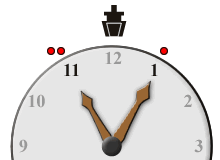Remembering the Collision Regulations' sound signals
The sound signals used in the collision regulations are vital yet can be complicated if you do not know Morse Code. Fortunately it is quite easier to create mnemonics for them.
Note: the interpretation of the collision regulations below is sometimes simplified for the purpose of remembering. Always check a copy of the regulations for the full definition.
Sound Signals for Manoeuvring
| Signal | Description | Mnemonic |
|---|---|---|
| The first choice when meeting another vessel head on would be to turn to starboard, so one short blast means turning to starboard. | See clockface below | |
| The second choice when meeting another vessel head on would be to turn to port, so two short blasts means turning to port. | See clockface below | |
| The third choice when meeting another vessel head on would be to go astern, so three short blasts means going astern (strictly speaking, engines in reverse). The engines are in threeverse! You could also imagine a propellor (it obviously helps if you see three blades when you think of a propellor). |  |
|
| If you didn't know what the other person was doing, you might sound many blasts in panic, so five short blasts means "Make your intentions clear". The word PANIC has five letters. |
 One way of remembering the first two signals is to think of a clockface. If you imagine the overtaking vessel at the centre of the clock and the ship being overtaken at the twelve o'clock position, then passing to starboard would go through the 1 numeral so ONE blast, while going to port would go through the 11 numeral so two (ONE + ONE) blasts.
One way of remembering the first two signals is to think of a clockface. If you imagine the overtaking vessel at the centre of the clock and the ship being overtaken at the twelve o'clock position, then passing to starboard would go through the 1 numeral so ONE blast, while going to port would go through the 11 numeral so two (ONE + ONE) blasts.
| Signal | Description | Mnemonic |
|---|---|---|
| Four blasts indicate a pilot vessel. A pilot guides a ship into a harbour. Think of the four blasts as four raps on a door (rat-ta-ta-tat) to indicate that you want to come into a house. | ||
| The single long dash is sounded when approaching a blind bend in a channel. in the same way, a motorist approaching a blind corner might sound a long blast on his horn. | ||
| The double long blast indicates an overtaking manoeuvre. Think of the two long blasts as two ships in line, one about to overtake the other. | ||
| The overtaking ship sounds two long blasts to indicate overtaking, then one short to show that it is moving to starboard (as in the single short blast above.) | ||
| The overtaking ship sounds two long blasts to indicate overtaking, then two short to show that it is moving to port (as in the double short blasts above.) | ||
| This signal marks agreement from the overtaken ship. Think of it as one ship asking OK and the other agreeing OK |
Sound Signals Mnemonics in Restricted Visibility
Restricted visibility signals start with a long blast. Imagine it long so as to give you time to focus on where it is coming from.
| Signal | Description | Mnemonic |
|---|---|---|
| The most common ship at sea is a powered vessel so it has the simplest signal – a single long blast. (This signal is for underway, not making way). | ||
| The long and two short blasts is given by vessels which cannot manoeuvre as easily (not under command, unable to manoeuvre, restricted by draught, fishing, towing, sailing). Think of it as the ship warning "oh-oh". | ||
| A vessel under tow, if manned, gives a long blast and three short blasts. Imagine it as the tug dragging three barges behind (TUG and TOW both have three letters). |
At Anchor
 At anchor, a vessel sounds a bell. Like a buoy, the vessel will stay in one place. A buoy's sound signal is often a bell as well.
At anchor, a vessel sounds a bell. Like a buoy, the vessel will stay in one place. A buoy's sound signal is often a bell as well.
A vessel at anchor sounds a bell for five seconds every minute. You could think of the bows of the vessel as a V (seen from above) which is the Roman letter for 5. A traditional anchor (left) also has a clear V shape.
Aground
![]() A (large) vessel aground show three balls in line during the day. As a sound signal, it sounds three strokes of the bell before and after the normal five seconds ringing for anchoring (see above).
A (large) vessel aground show three balls in line during the day. As a sound signal, it sounds three strokes of the bell before and after the normal five seconds ringing for anchoring (see above).
 Help for
Help for